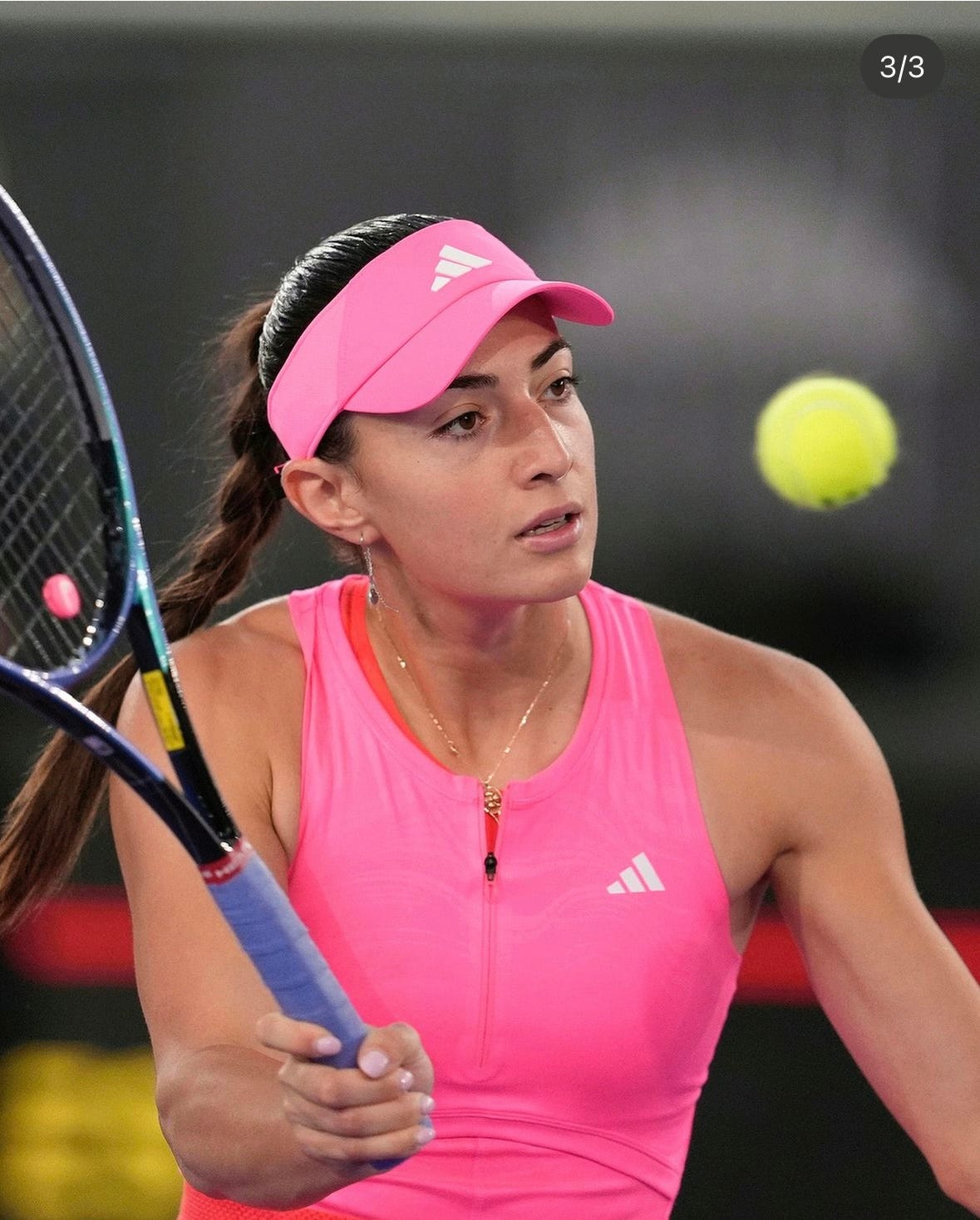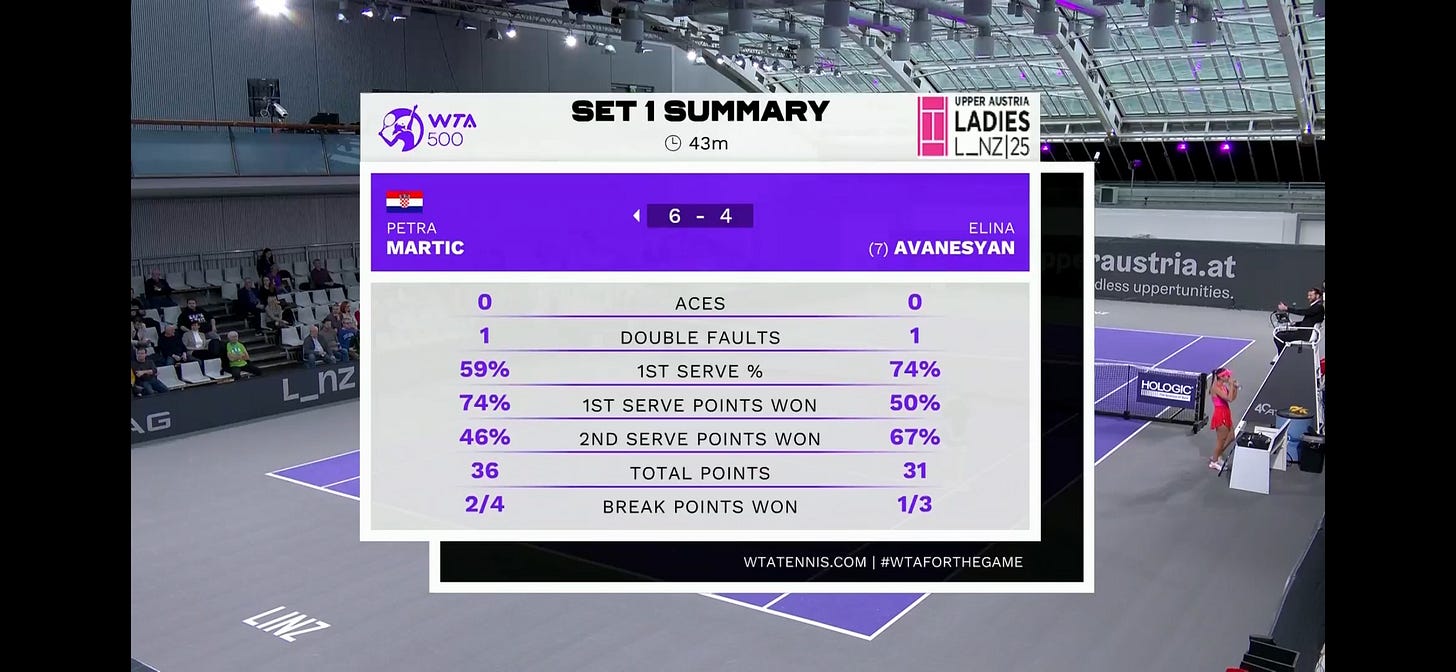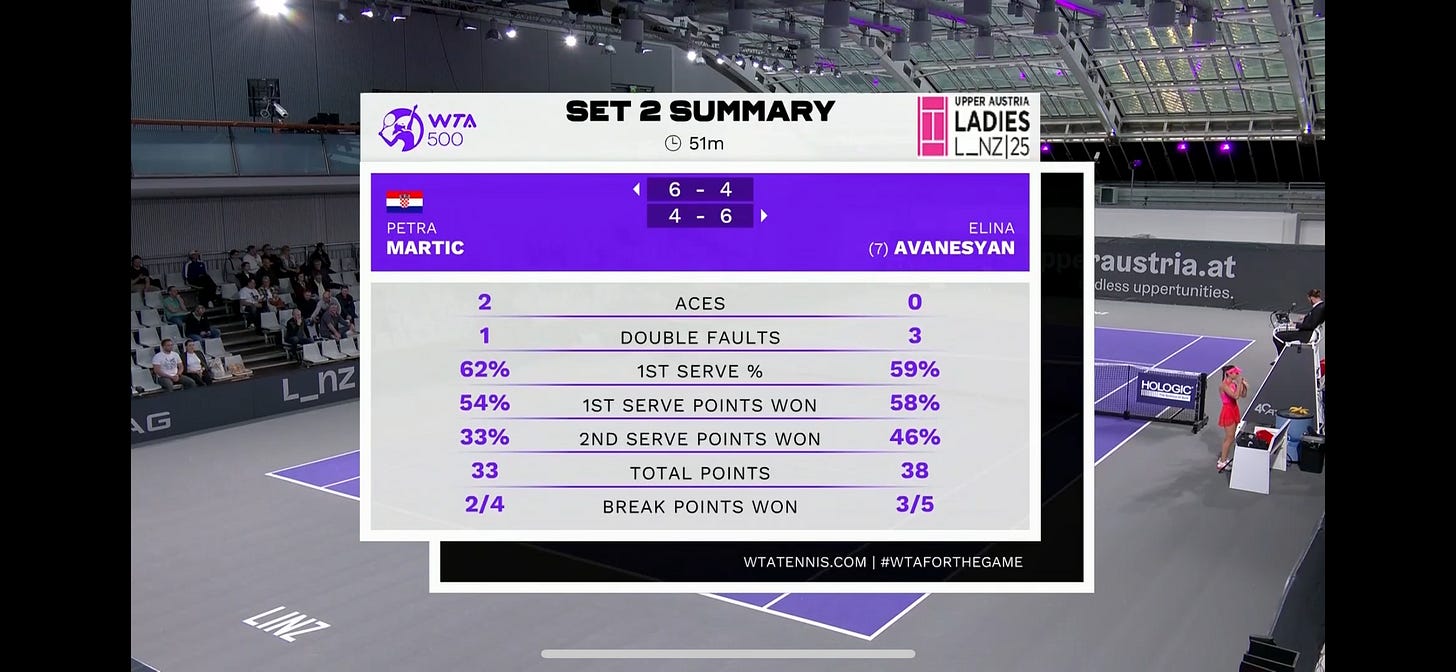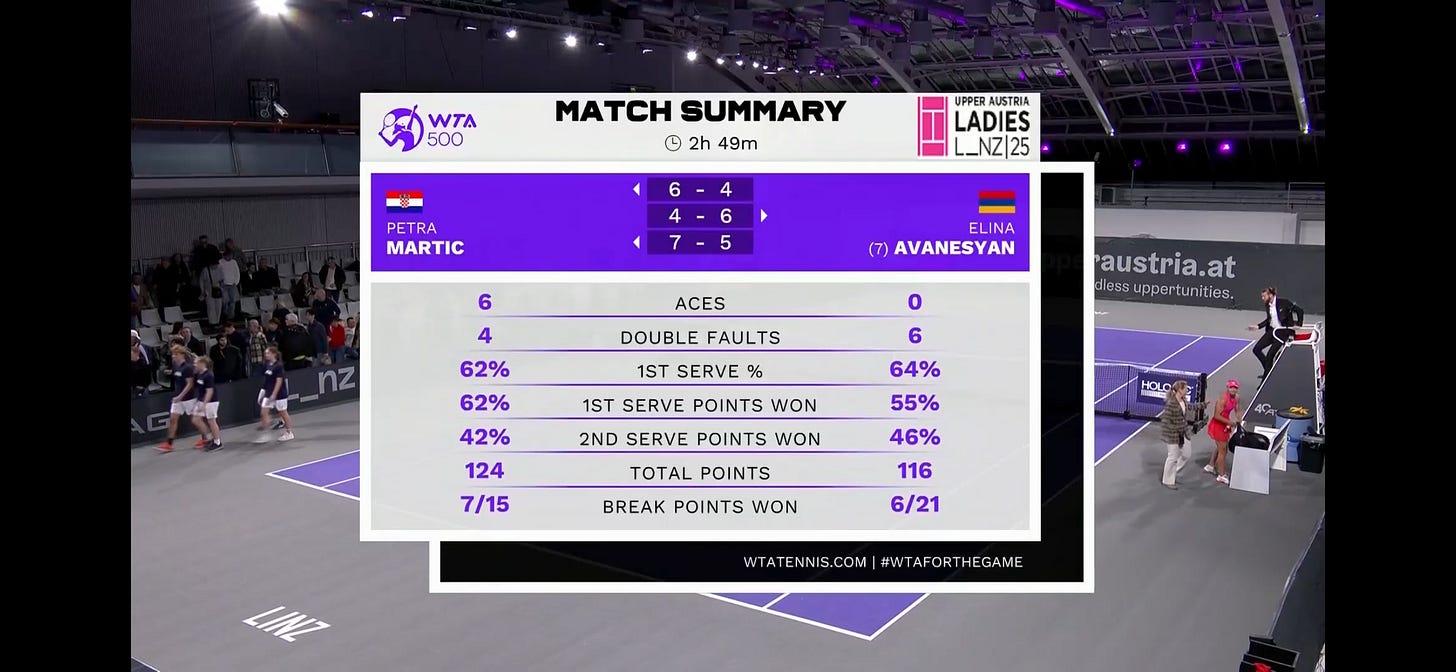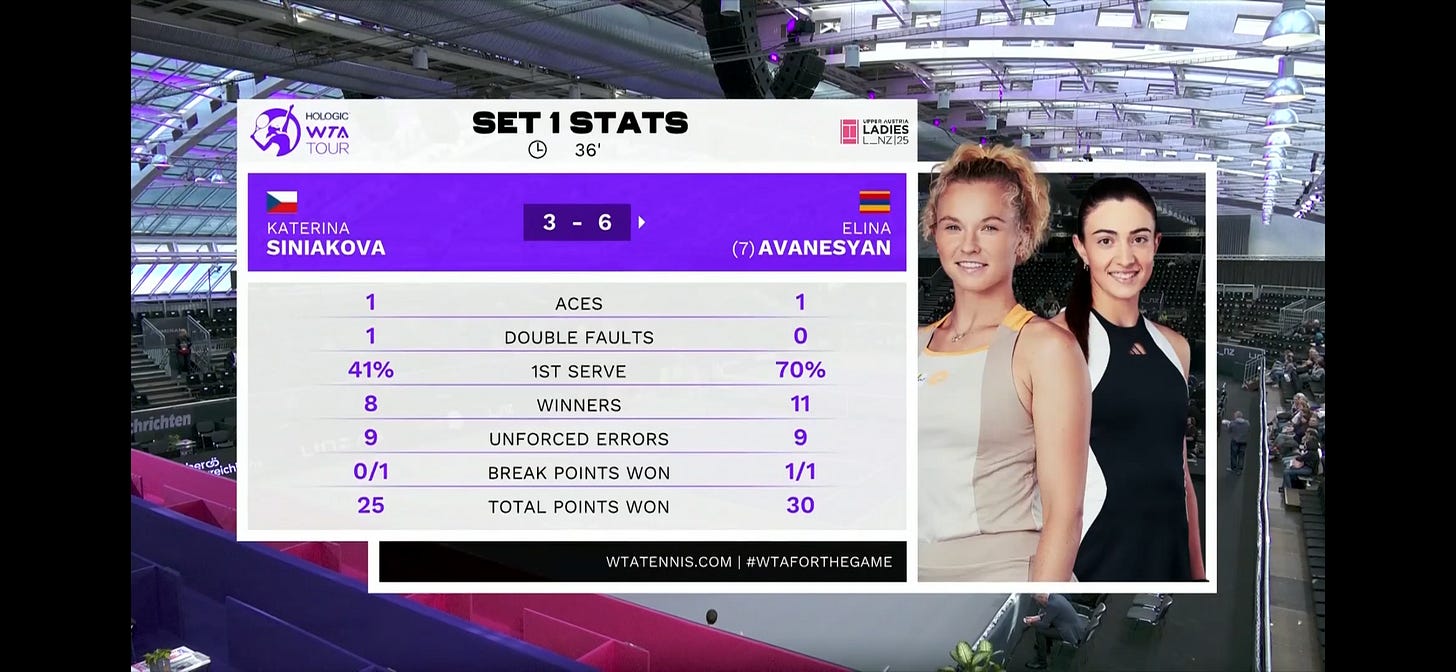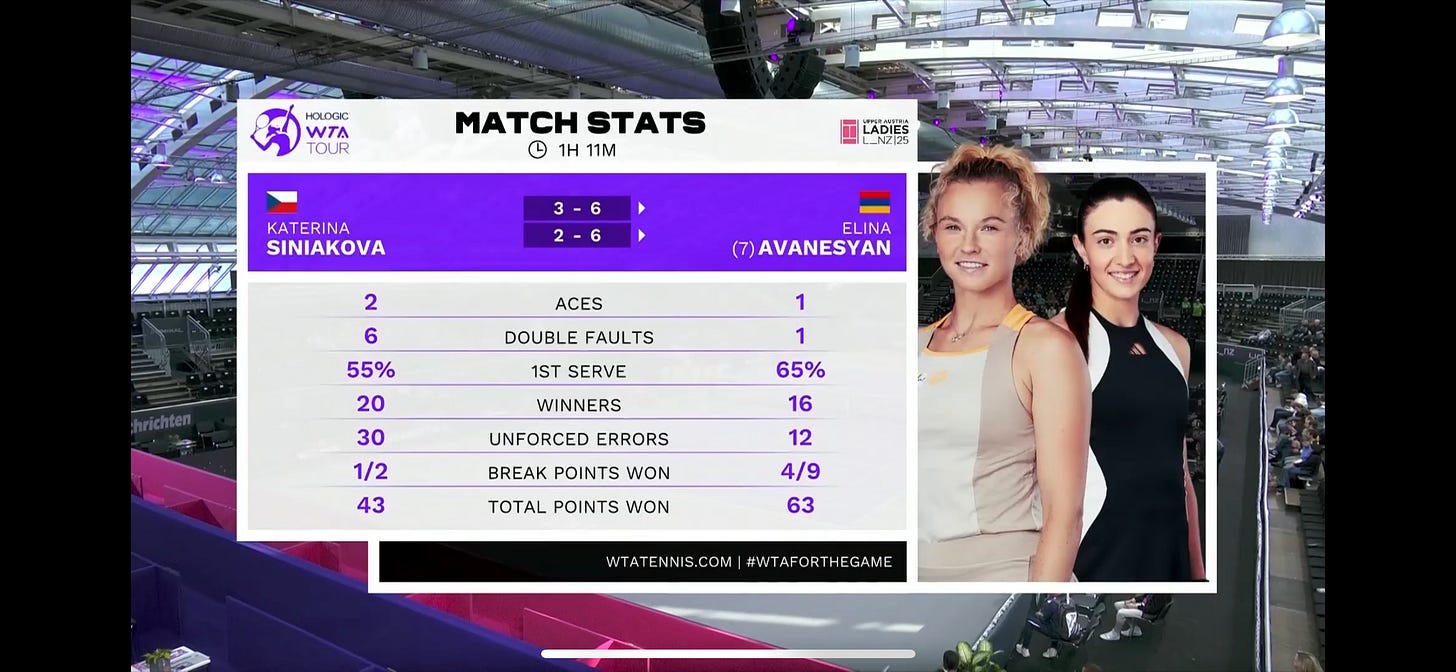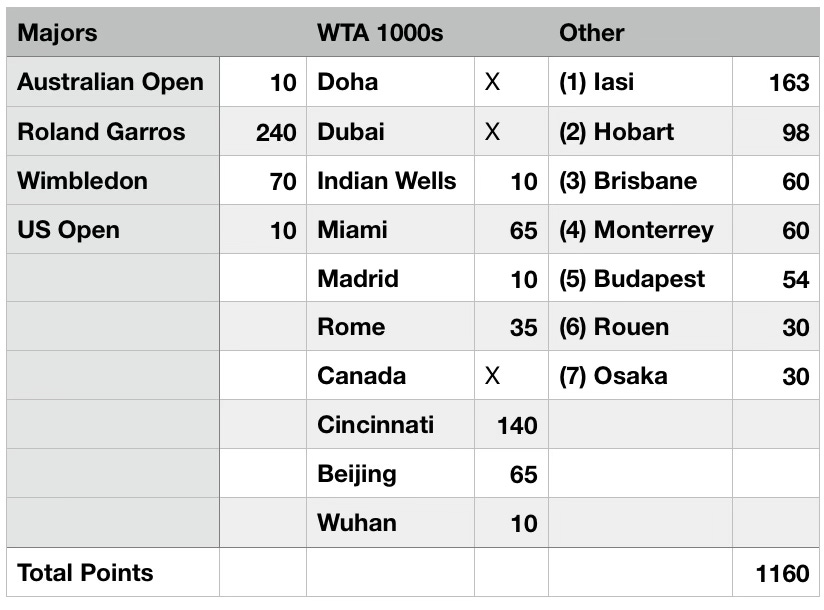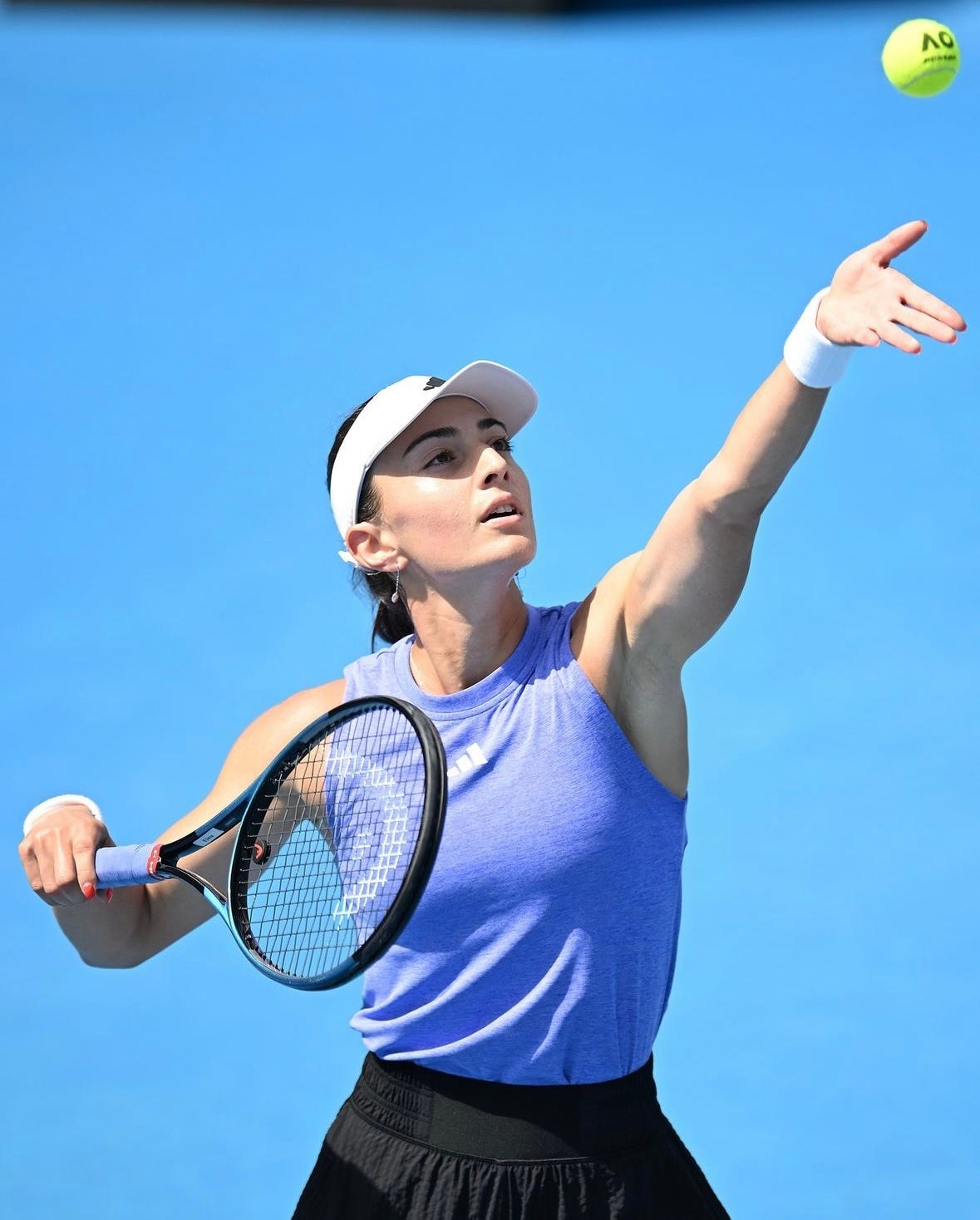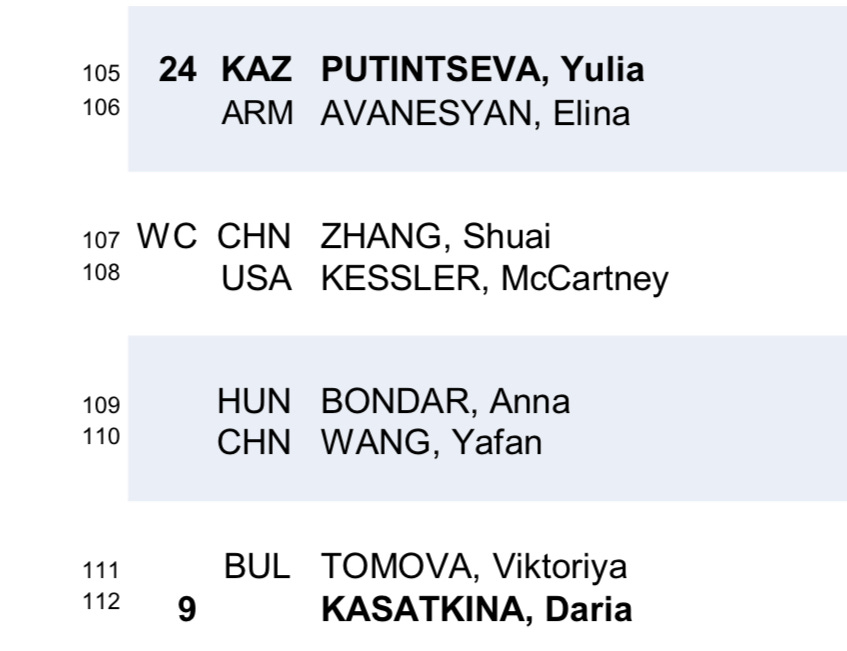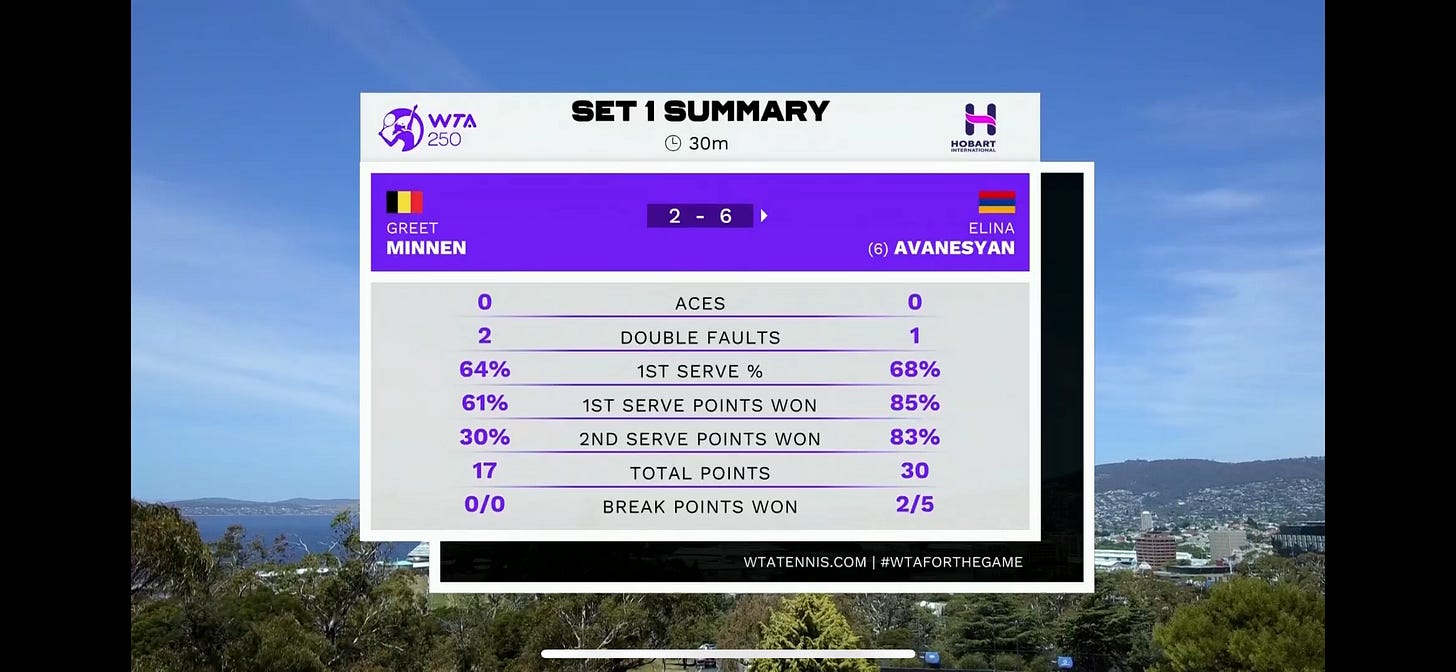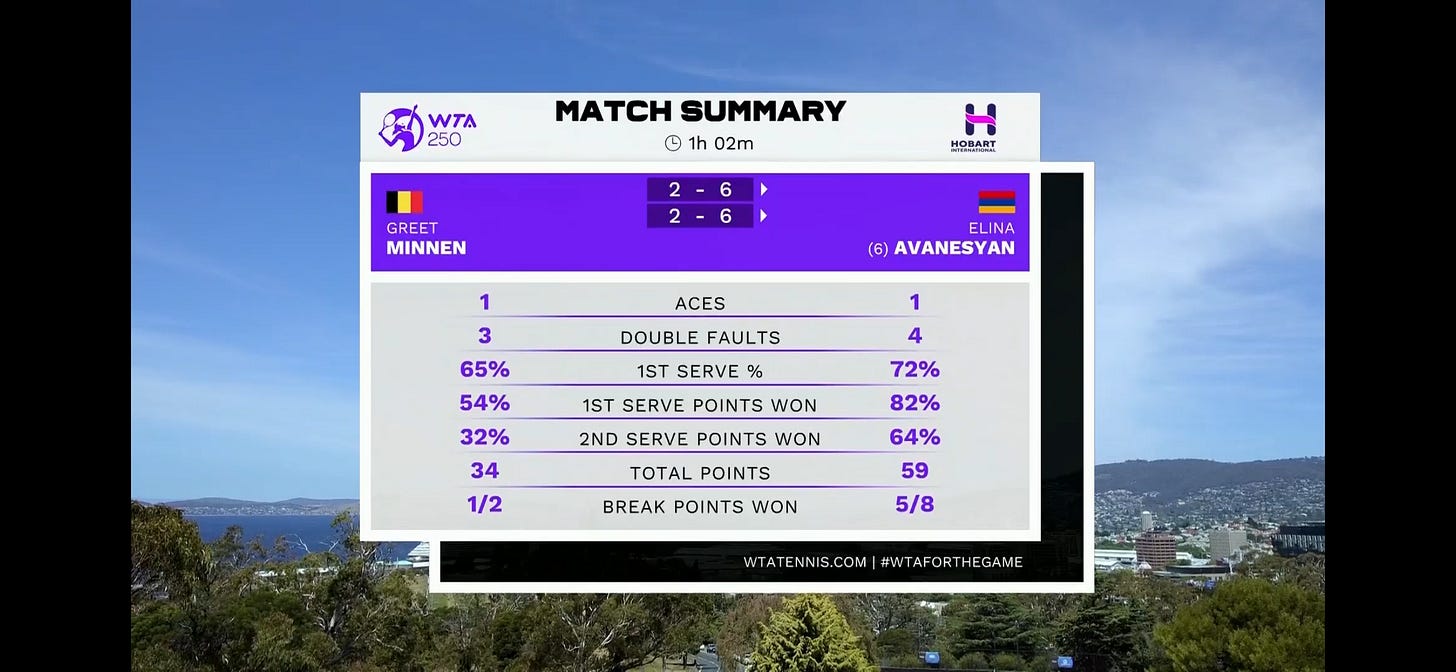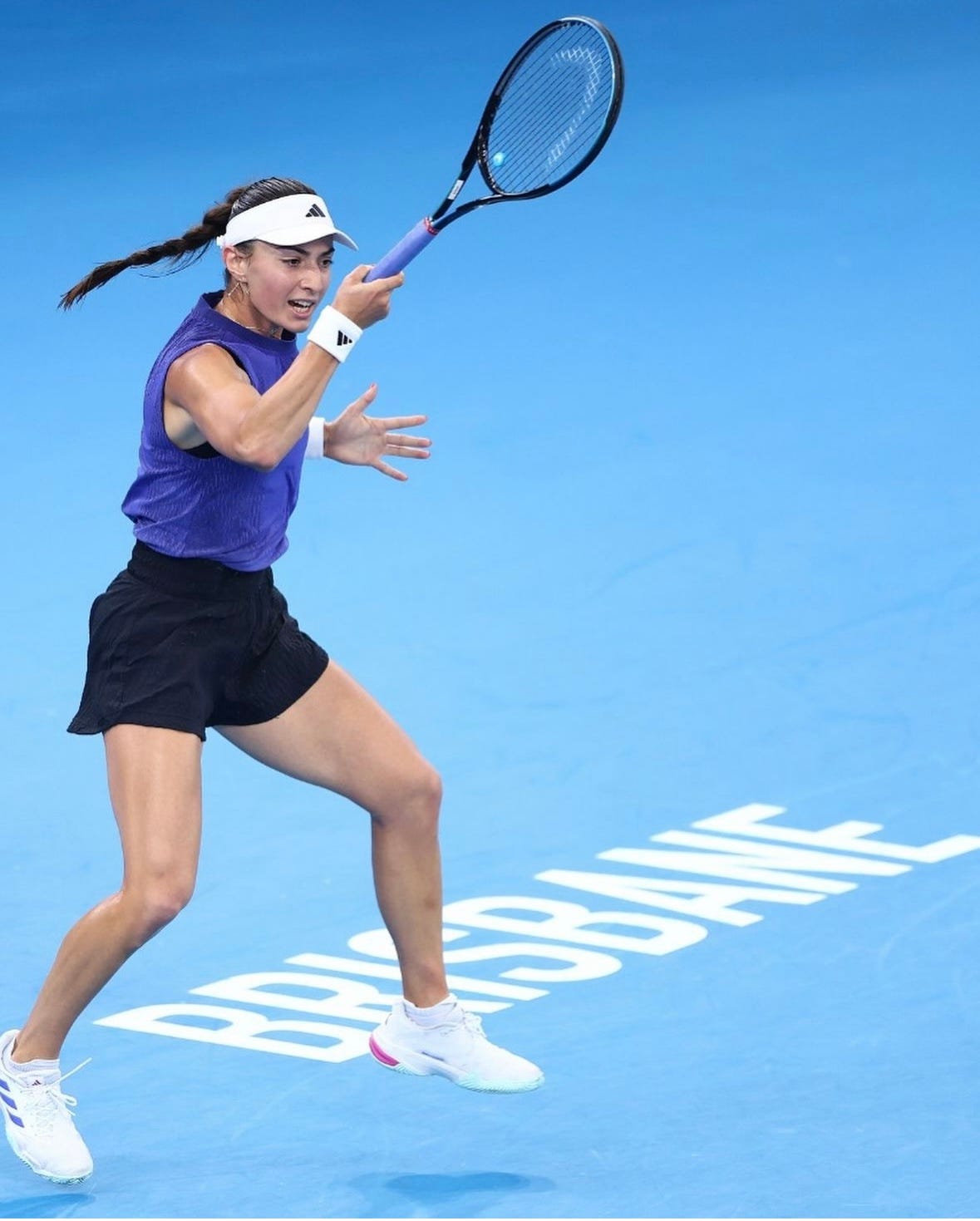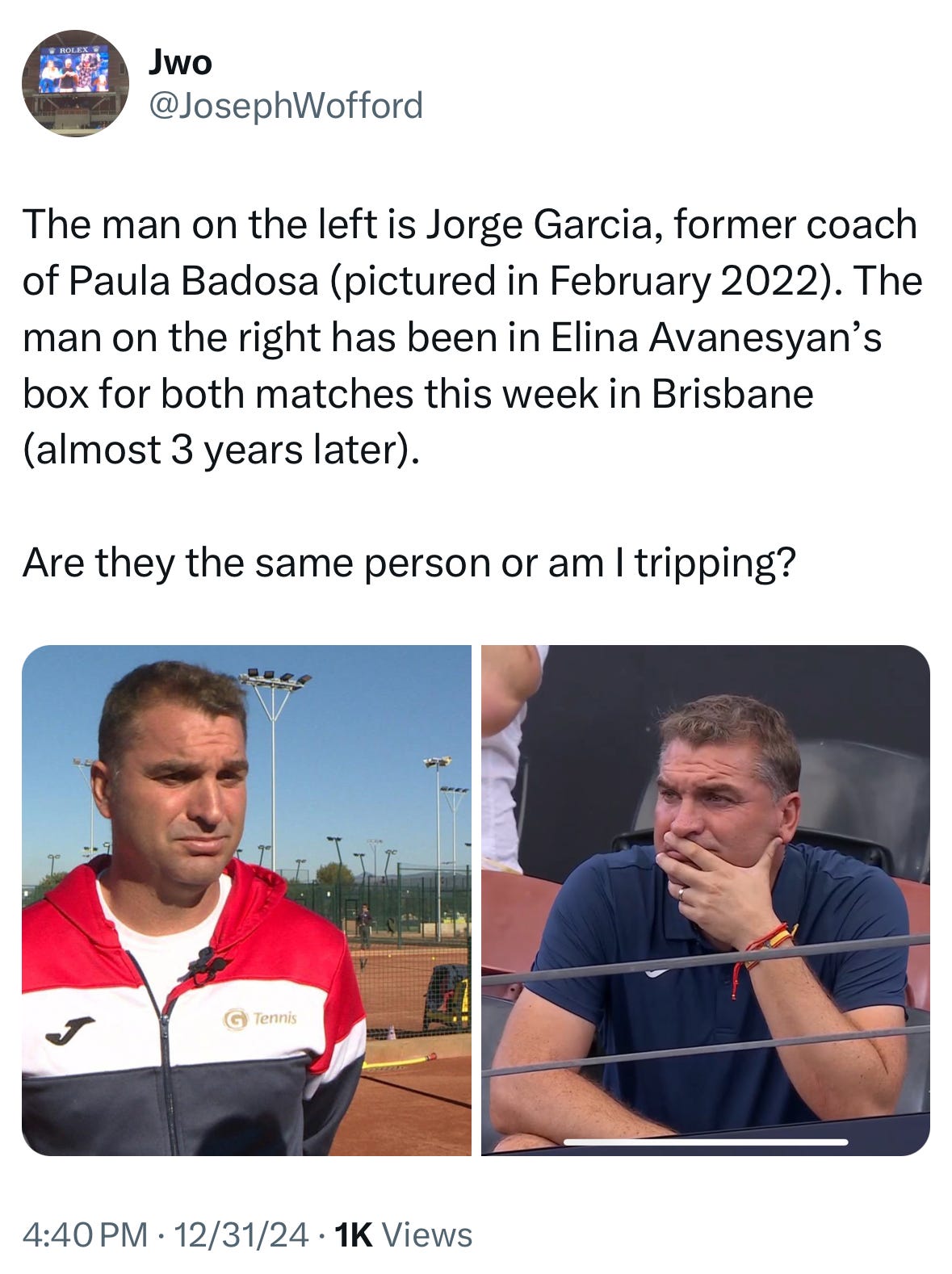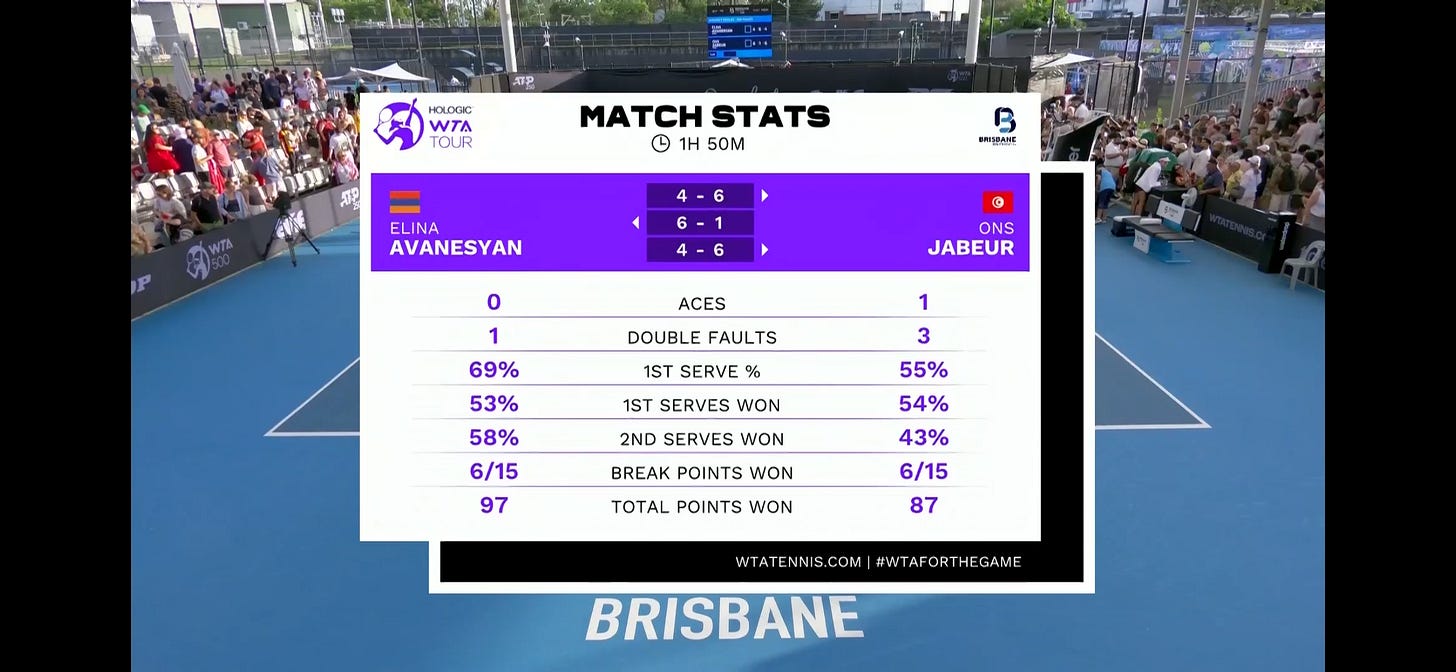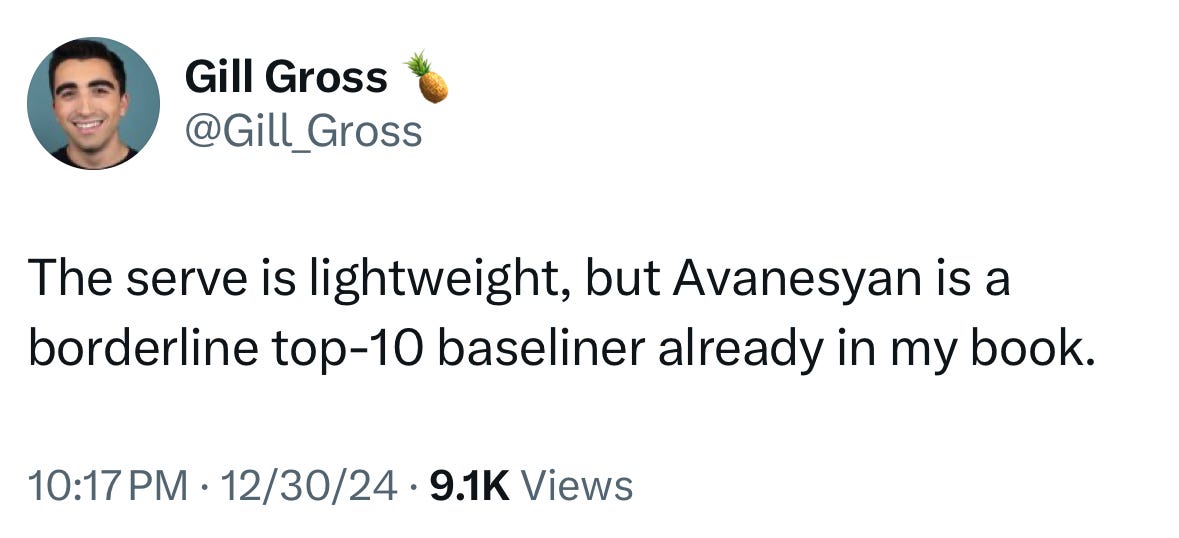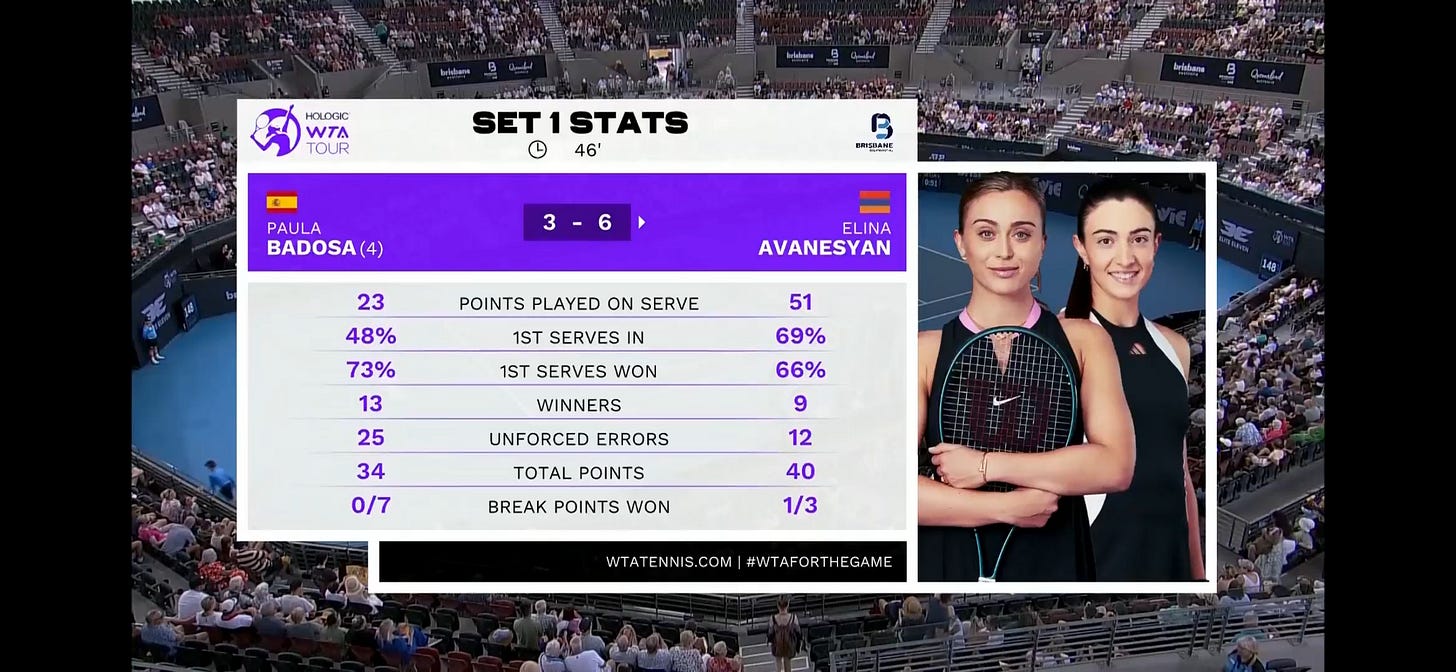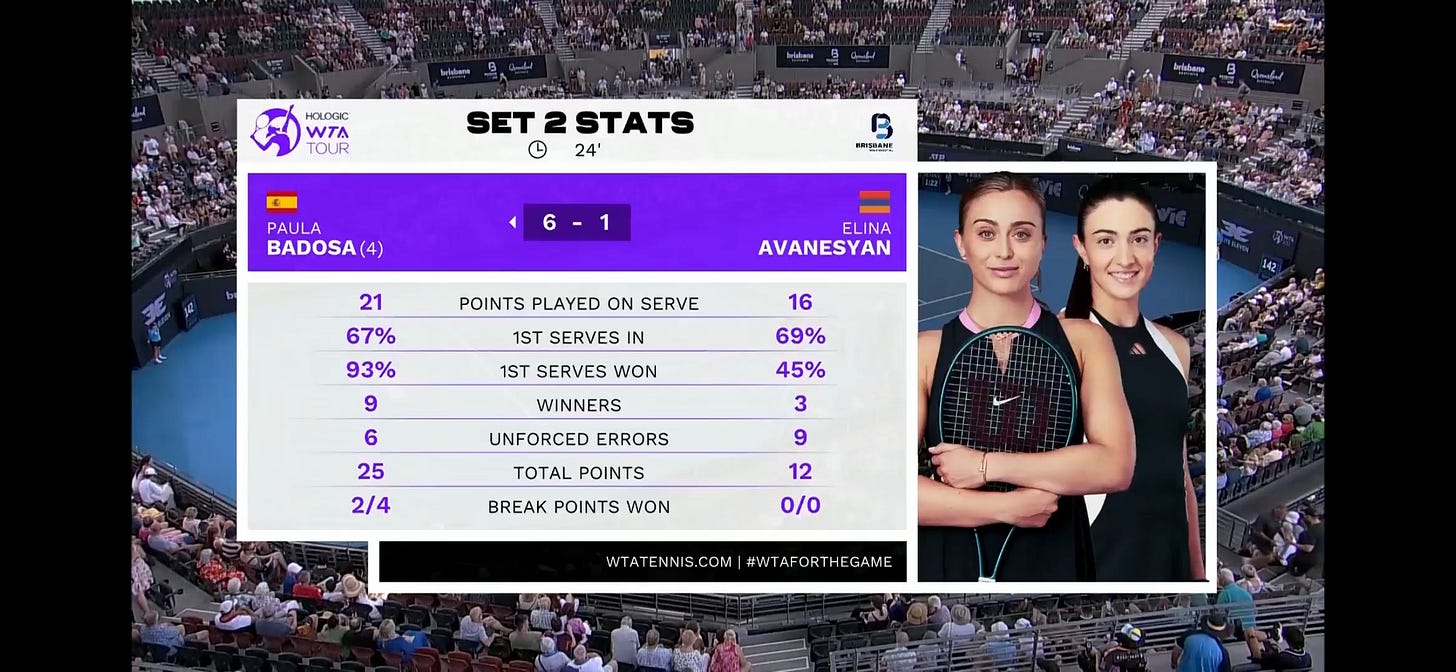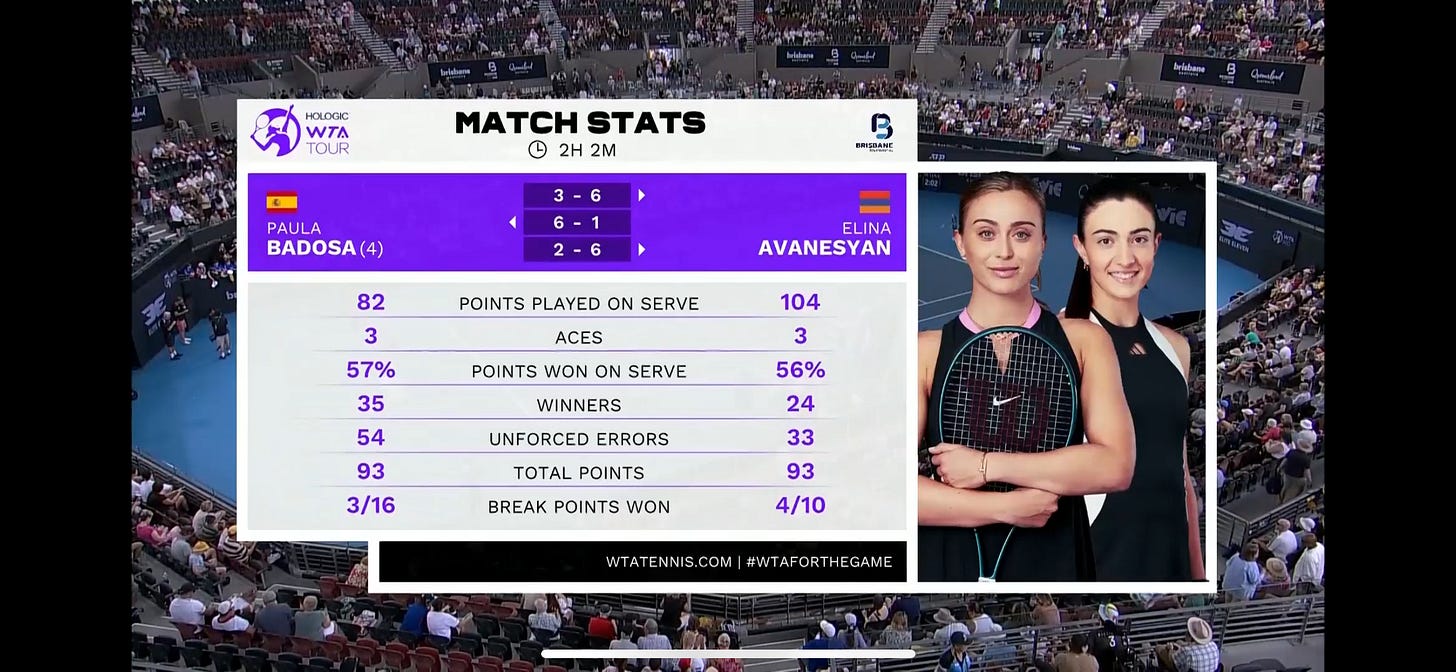Welcome to my Nesy-verse!
Since becoming an avid Tennis Twitter poster in 2022, I’ve struggled to find a way to produce reflections and analysis about tennis in a way that is satisfying to me. But increasingly, what brings me joy in relation to tennis is watching and talking about Elina Avanesyan.
This journal is an experiment in putting my match analysis somewhere other than twitter. Especially with a lesser known player like her, I don’t find tweeting to be very rewarding. Most of the limited engagement I do get I get is from friends who are happy for me when Nesy wins, not people who watched and/or want an account of the match. By keeping the journal I can keep those things seperate. Now I can tweet in celebration or along with a match and people can engage with that, while my more extensive thoughts about Nesy can live here.
I want the journal to be the definitive resource on Nesy’s 2025 season. (I don’t want to have to go to TennisTonic ever again) I want to come back to it and update it match by match. I want it to have stats, but also detailed summaries of the matches, and occasionally more general thoughts.
Elina Avanesyan 2025 Journal
(Entries are in reverse chronological order with newest updates at the top and season stats at the bottom)
Linz (500) -
1st Career Appearance / Seed: 7
❗️First time being seeded at a WTA 500❗️
(Photo via @WTA on Instagram)
❌ Martic d. Avanesyan 6-4 4-6 7-5 (2:50)
Nesy’s tournament ended in the round of 16 as she was defeated in 3 sets by the 125th ranked Petra Martic. Martic, a former top 15 player whose ranking has dropped precipitously, qualified for this event and then defeated Eva Lys fresh off her run to the Australian Open 4th round. Nesy had already defeated Martic in their two prior meetings, although their match last summer in Iasi was highly competitive, so she was a considerable favorite coming in. What made this meeting different to their 2 prior meetings were the conditions. The indoor conditions provided an edge to the bigger serving Martic, who dominated behind her first serve. They also made it significantly harder for Nesy to hit through the court, creating the opportunity for Martic to defend with crafty slices and tricky lobs. Martic’s greater raw firepower, particular off the forehand, allowed her to more effectively hit through the conditions and to hurt Nesy with big crosscourt-counterpunches.
✅ Avanesyan d. Siniakova 6-3 6-2 (1:12)
Nesy defeated the world number 50, Katerina Siniakova, in her first match since winning the AO Doubles title. Katka played the final on Sunday afternoon in Australia and then had to fly to Austria for a Wednesday match. Nesy, meanwhile, hadn’t played a tennis match in over 2 weeks. The difference in energy and preparation was obvious throughout.
I had been worried about the draw going into Nesy’s opening match. All the signs pointing to Siniakova were impossible to ignore: the AO doubles title, the respectable showing against Swiatek in the singles, not to mention the fact that she’s Czech, which means she was practically raised on indoor hardcourts (conditions to which her big serving, net-rushing power game is excellently suited). Nesy hasn’t proven herself on this surface, she’s barely played on it at tour level, but there were obvious reasons to think her game, which thrives in slow, high-bouncing conditions might not hold up inside. Instead, she found the center court in Linz to be most hospitable.
Even with these reasons to doubt, there were plenty of others signaling optimism. The first, Nesy’s excellent outdoor hardcourt form to start the season. No bad losses. Only respectable ones to Jabeur, Kessler, and Putintseva (21, 26, and 16 in the Race respectively). Her forehand has become more of a weapon and less of a liability on this surface. It’s been the key to her early success. You had the sense that if she could serve a bit more aggressively and put Siniakova in defensive positions with her forehand, she’d have an opportunity to win the match.
(From defense to offense, spreading the court with her forehand)
The other reason for optimism was Siniakova’s short turnaround, as well as her poor recent record in the opening round of WTA events: she’s now lost first round in 6 of her last 12 tournaments played.
In the end, Nesy played surprisingly well, adopting a more aggressive mindset and proving that her forehand now holds up even in these tricky conditions (perhaps she was helped by having those 2 weeks to prepare). Her down the line forehand was the best shot on the court. She attacked Siniakova’s backhand, which leaked errors under pressure, and exposed her limitations as a returner (particularly on the forehand wing) and a defender.
(Point of the match; staggering depth and rally tolerance to secure the break)
(Beautiful footwork, not troubled by the low ball to her forehand)
Still, it should also be said that this was a poor performance by Siniakova’s standards. Her ball toss was an absolute mess from beginning to end. She barely made 40% of her 1st serves in the 1st set. She had 6 costly double faults that cost her multiple service games. Other than one game early in the 2nd where she saved 4 break points with stelar defense and then forced her way to net – she still lost it because of her serving – she was poor in the pressure moments and looked dejected throughout. When Nesy served for the match, she gave the game away with 4 poor unforced errors.
Nesy had her wobbles. She nearly blew leads on serve at 4-2 and 5-3. Her 1st serve deserted her and she started spraying errors. Nesy’s response from break point down at 4-2 was her finest moment of the match (see video ⬇️)
Still, at other times, Siniakova let her off the hook with poor forehand returns and a slew of overcooked unforced errors.
It’s an exciting victory for Nesy, especially because of how easily she made the transition indoors look. However, Siniakova’s level should give us some pause. Her lapses in concentration, as well as some weaknesses in her game that I’ll go on to explain momentarily, were on full display. She has a very friendly draw with Petra Martic, an opponent who she leads 2-0 in their head to head, so hopefully she can win that, but then there are concerns. She could meet Alexandrova in the quarterfinals and she might get hit off the court.
Even if that happens, a quarterfinal here would be a completely successful week. It would get her back up into the top 45 and, with no points to defend between now and Miami, see her poised to break into the top 40 for the first time in her career. Since she got the late start she’ll play everyday going forward until she loses (or wins the title). After not being able to watch her play a match for 2 weeks, 3 matches in 3 days (or more) would help to make up for it!
Now, as promised, I want to go into more detail about what worked and what didn’t in Nesy’s game today so we can keep an eye on those areas in the future.
It’s great to see this more aggressive version of Nesy on serve + forehand. She won 79% of her 1st serve points today, which is up nearly 20% from her season average. She reverted to the kick serve when she got tight (and tended to miss them anyway), but mostly she served more aggressively to great effect. Her serve speeds were creeping up toward 170 kmph, instead of hoving at 160 or below. This is all good and a sign of her adapting her game to conditions that suit a more offensive approach. The more aggressive 2nd serve return position her coach has had her take up is also paying off right now for the same reasons.
She also took the opportunity to do more of what she tried to do against Putintseva: coming forward to shorten points. Net game will never be her strength, but she won a couple of big points, including set point in the first, by committing to coming forward and crashing the net. Her approach shots were not particularly good, she barely split-stepped, but her anticipation was spot on, and, crucially, after an early point where she hit her approach and just stopped – allowing herself to get beat by a dipping pass – she barreled her way forward, making sure to get as close to the net as possible.
(The first time she hesitates coming forward)
(The second time she’s much more assertive; excellent anticipation)
Those points aside, what’s really working for her is her pinpoint precision in rally, which allows her to get an attacking player like Siniakova onto the defensive and move her corner to corner. But, as good as her point construction is, there are two shots in particular that tend to undo all her hard work in the rally.
The first weakness is on the backhand side, and it emerges when she gets a bit rushed and tries to play the backhand up-the-line. She tends to not fully commit to this swing and will not only leave the ball short, but also give it way too much height over the net. She’s not getting down, absorbing the pace, and redirecting it flat and low over the net. She has the ability to flatten out her backhand, but she’s been struggling a lot with the margin recently.
Siniakova was able to find that backhand wing and then step in to crush the next forehand.
(Not staying down through the backhand redirect, too much net clearance, landing short; 3 examples)
I’ve written recently about how her backhand, which used to be her more effective shot, has become more of a liability as her forehand has taken off. This issue is another example of that. While she’s driving through the crosscourt backhand better than ever, she’s had a lot more trouble being effective going up the line, both in offensive and defensive positions. At the moment, she’s becoming a bit more of a one dimensional clay-courter. Without the ability to go backhand up the line effectively from offensive and defensive positions, a la Iga Swiatek, you become a player whose backhand is constantly under attack and you don’t get as many opportunities to play your favorite forehand. This is an area where I’m not expecting improvement overnight. I expect it’s going to be a shot that holds her back at times this year.
The other issue is with her improved forehand, particularly her ability to flatten out the ball and finish the point crosscourt. Nesy can flatten out her off-forehand very effectively, but when she goes cross, she tends to heavily spin it. This can be very effective in the rally, dragging her opponent wide and pushing them back at the same time. But when she has the entire forehand corner open, she tends to overspin the ball and leave it short so that the opponent has the time to track it down.
(Long rally featuring excellent defense to offense to Siniakova; notice halfway through when Nesy hits the sharply angled crosscourt backhand, but then can’t do enough with the crosscourt forehand to end the point)
(Siniakova’s best point of the match; defense to offense. Notice how Nesy starts strong, but loses control of the point when she can’t do enough with the 6th-ball crosscourt forehand)
This lack of a flatter crosscourt forehand to finish points really show up against the players who are the better movers. It’s why, along with her attackable 2nd serve, she can get demolished by a speedy player with some pop like a Paolini.
If she improved in those two areas, I think she would definitively be a top-10 baseliner. I’m not really expecting that anytime soon, but it will be worth watching if these weaknesses continue to show up and what she’ll do to address them.
New WTA Rankings - Jan 27, 2025: #49 (-8); 1160 pts. (-120)
This week, Nesy’s ranking dropped from 8 spots, from #41 to #49. Her first round loss to Yulia Putintseva at the Australian Open guaranteed that she would fall, but it could have been worse. Olga Danilovic, Naomi Osaka, and Rebecca Sramkova were the only players ranked below Nesy to do well enough in Melbourne to pass her based on points gained and none of them went on especially deep runs. The seeds performed well at this tournament overall, and as a result there was nothing akin to Yastremska’s run to the semifinal last year that could have really disrupted the rankings. Additionally, one of the spots will be coming back without Nesy having to do anything. Karolina Pliskova is ranked #46, but isn’t currently competing on tour. She’ll drop out of the top 50 next week.
Meanwhile, Nesy has 0 points to defend until the Miami Open. Without winning a single match between now and then, Nesy has the chance to climb as many as 5 spots in the rankings. Marketa Vondrousova, Naomi Osaka, Lulu Sun, Anhelina Kalinina, and the previously mentioned Karolina Pliskova all have to defend points within the next month or Nesy will pass them.
It’s a cruel quirk of the tennis ranking system that players often achieve their career high one week, only to suffer a big drop in the rankings the next. Players tend to hit their peak ranking about a year out from their biggest result because since they’ve had the full 12-months to benefit in terms of seeding and automatic qualification that result made possible. Hopefully, they’ve done enough in that time to offset the damage to their ranking should they fail to defend them. Nesy definitely did.
Still, Round 3 at the Australian Open wasn’t Nesy’s best result last year, it was actually fourth behind Roland Garros, Iasi, and Cincinnati. Making a career high at the 12-month mark of your 4th best result from last year suggests that there’s still plenty of room for her to rise. If her fitness and form keep up with what I’ve seen so far, she should have opportunities to reach career highs the week before each of those tournaments and this moment where she almost fell out of the top-50 will be a distant memory.
Australian Open (1/12-1/26) - First Round (10 points)
❌ Putintseva d. Avanesyan 4-6 7-5 6-2
I stayed up until 2 am watching Nesy lose this match, but even having said that, I’m not that disappointed. First things first, it was a pretty unlucky draw. Of all the possible first round matchups Nesy could have had, Putintseva was probably top-15, if not top-10 most difficult. Obviously you’d take her over the likes of Aryna, Coco, and Iga, but her form and confidence, combined with her excellent defense and variety make her a difficult matchup for Nesy, who doesn’t have enough power to hit through her easily. Putintseva’s serving (specifically her accuracy and ability to create angle off the court with her slice serve) and ability to absorb big returns allowed her to hold 11/15 service games. Her defense making Nesy have to produce quality shot after quality shot to win points behind her serve.
Another reason I find it hard to be too disappointed is that Nesy played considerably better here than she did against Kessler. She had a much better balance between offense and defense. Yes, there were still errors – especially and somewhat worryingly off the backhand – but not nearly as many of them were shot selection errors. She wasn’t playing like Ostapenko, ending every point on her terms. Instead, We saw a lot more of those vintage Nesy defensive rallies where she’s going side to side over and over, throwing up lobs. We saw some great moonballs from her, often countering Putintseva use of that tactic. We even saw her ready for dropshots, as well as shorter/floaty balls and looking to transition forward. It’s also true that some of the biggest errors of the match came from Nesy in the forecourt. A brutal missed overhead into the net and a sitter backhand crosscourt put away shoved wide, both occurring on key points when Putintseva was under pressure on her serve, stand out. It’s not surprising that she’s just not that comfortable finishing points up there. But it was the right play against an opponent who defends from so deep and will bring you forward on their terms if you don’t find a way in on your own. It was also something she completely refused to do against Kessler (I wrote it off in my previous post as just something she wasn’t really willing to do), so to see her make the adjustment and being trying to utilize it just one match later? That’s a big deal.
This was really Nesy using her full arsenal, playing a tactically sound match that accounted for Putintseva’s strengths (the slice serve and the dropshots especially), and made big improvements from the previous match. Yes, I wanted the win, but what I saw was Nesy doing everything right and just being outplayed. In the end, Putintseva was just the better, more confident player. She started a bit slow and had the one big let down serving for the 2nd set at 5-4, but compared to Nesy who played at least one really bad service game in each set AND had lapses at the start of sets 2 and 3 also? There was no comparison.
Since I brought up my concern with the backhand, let me say a bit more about it here. You’d expect that shot to be old-reliable for her on a hardcourt, but its been a mixed bag. I feel like she’s hitting the backhand cross bigger and better than ever, but her backhand down the line seems to have regressed, or at least stagnated. She struggles at times to generate her own pace on it (her most common miss is the net, but she missed a couple by meters too) and she also gets rushed into error by balls at her feet more often than I’d like. The backhand down the line used to feel like her best shot, especially the one up at shoulder height. It’s just not nearly as reliable and damaging a shot as I’d like it to be, especially compared to the forehand.
I’m ultimately much more disappointed by what happened in Hobart than I am about this. That was a much worse performance against a beatable opponent that would have put her in a WTA final with an excellent look at a title. Yes, she loses 120 ranking points and is at risk to fall out of the top 50, but she could also stay at 48. All and all, I’m happy with the performance and put the loss down to an unlucky draw. I’m excited for her to play in February. She didn’t play Dubai or Doha last year. Great opportunities in the near future to pick up points!
New WTA Rankings - Jan 13, 2025: #41 (+3): 1280 pts. (+68)
Nesy reached a new career high #41, picking up 68 ranking points with a run to the semifinals in Hobart. She continues to hover at the very edge of the top-20 in the race rankings. She has 130 points to defend in Melbourne and a very difficult round 1 opponent. She’ll drop to #48 in the live-rankings if she loses in round 1 and there’s a very good chance she would be outside the top-50 by tournament’s end. Even if she pulls the upset, she’ll likely have to face Kessler (who just beat her) again in round 2. It seems very unlikely that she’ll be defending all her points, but she rocked up to Roland Garros last year with 240 points to defend and somehow pulled it off.
Hobart (250) - Semifinal🥉(98 Pts.)
1st Career Appearance
❌Kessler d. Avanesyan 6-4 3-6 4-6
✅ Avanesyan d. Anisimova (Walkover)
✅ Avanesyan d. Minnen 6-2 6-2 (1:02)
✅ Avanesyan d. Wang Xiyu 6-3 7-5 (1:35)
Photo via @hobart_tennis Instagram
❌ Kessler d. Avanesyan 6-4 3-6 4-6
Nesy’s run at Hobart came to an end with a collapse from a set up to the American McCartney Kessler (#67). Kessler, having already defeated the 7th seeded Sramkova and the top seeded Yastremska, showed her excellent baseline game and beat Nesy with her defense and counterpunching, as well as some crafty variety.
This matchup felt like watching Nesy play an earlier version of herself. Kessler mostly spun her forehand up the line to Nesy’s bh, forcing her to contend with balls bouncing above her shoulder. Then defended extremely well, especially out of the backhand corner, which is Nesy’s preferred target off the forehand and backhand. Kessler is 5’ 9” with a long wingspan and she showed herself to be an excellent lateral defender. She reset points with slices and lobs out of the corners, forcing Nesy to produce one powerful strike after another, eventually leading to an error.
Faced with these all too familiar tactics, Nesy found herself in the unusual role of the all-out-attacker. This is probably the most consistently offensive I have ever seen Nesy be in a match. Unfortunately, the errors started coming as soon as Nesy got up 3-1 in the first, and they never stopped.
I’ll talk about the tactics in a minute, what I thought she got right and what she got wrong, but the most frustrating thing to me was the one-dimensionality of her performance. She was absolutely wailing on the ball. Some of the biggest hitting I have ever seen from her. The first 4 games of the match, the quality of her ballstriking was breathtaking.
But as Kessler’s level improved and she made adjustments, Nesy’s response was to continue to try to impose herself with brute force. She would land a powerful blow deep in the court, pushing Kessler back. Then she would go for the big off forehand, or the backhand down the line. But Kessler fended off the body blows and consistently neutralized Nesy out of the corners. And eventually, Nesy would go for a high backhand or get rushed by a deep counterpunch and miss. There was never really any alteration of this dynamic. Nesy did put a lot of pressure on Kessler serve, breaking her 3 times in the 3rd set, but as the match progressed and the errors piled up, the momentum swung decisively towards Kessler.
The obvious counter to Kessler’s tactics would have been either to use the drop shot to punish her defensive court position, or to recognize and move forward to cut off floaty defensive shots for easy volleys. Unfortunately, these aren’t really things Nesy has in her game. She hit 2 dropshots and missed them both in the net. She never moves forward to cut off the ball in the air. She only rarely move up to take lobs as swinging volleys, preferring to try to play them on the rise. It’s frustrating to be able to see these things as a fan and for Nesy to not act on them, but ultimately her game is her game. I’m not going to criticize her much for not using skills she just doesn’t have. The better criticism is the one that recognizes that even without being able to deploy the dropshot or rush the net, there were things Nesy could have done in this match that might have gotten her the win.
What I would have liked to see from Nesy was more tactical variation. Let’s look, for example, at the 2nd serve return. In recent matches, Nesy has committed to being on top of the baseline to return second serves. She returns first serves from deep, but she was usually behind the baseline for 2nd serves as well in the past. That seems to have changed this season, I’m guessing because of her new coach.
And I get it. Nesy is one of the best players at winning first serves return points, but on second serves, it’s the more aggressively positioned (within reason) returners who dominate. It’s a clear area where Nesy can try to get more out of her game without going too far outside her comfort zone. And it was really working for her in set 1 where she won 8/10 2nd serves return points. Unfortunately, in set 2, she only won a paltry 2/13 2nd serve return points. (It improved slightly by set 3, but by that time breaking serve was not the problem).
What accounts for this swing in return points won is A) bigger kick 2nd serves from Kessler, and B) excellent pace absorption from Kessler which allowed her to fend off big 2nd serves returns. As a result, even though she was really going for it, Nesy’s returns were just not hit hard enough to overpower Kessler. Kessler got them back with depth, forcing Nesy to go for more and miss, or allowing Kessler to work her way into rallies and eventually turn the point in her favor.
Here’s where I would have liked to see something different. At times, Nesy could have dropped back to get a heavy return deep and force Kessler to try to control the point herself, with Nesy in a better position (deeper in the court) to defend from. Kessler was very defensive in this match. She counterpunched effectively and dispatched some high forehands, but a lot of the time when she was forced to go after a +1 or attack a lower ball, she misplayed them. Her approach shots were unconvincing and her volleys only so-so. Nesy helped her cause by letting her off the hook on some of these points. She hit her passes right to her on two important net points in the 2nd set. Her drop shots weren’t that great either, but Nesy was only willing to take her backhand reply cross, and Kessler was ready and waiting multiple times.
All of this is to say that Kessler’s offensive game has some big question marks, but Nesy didn’t do enough to make her have to answer for them. Switching things up on the 2nd serves is just one example of something she could have tried. Another, instead of trying to take the high backhand on the rise so often, she could have backed up and hit a moonball, forcing Kessler to make tough decisions about how to respond.
Somewhat to my chagrin, Nesy has mostly removed the moonball from her game. I think this is probably the influence of the coach and I find it kind of disappointing. The crosscourt backhand moonball that Nesy used to hit on the regular can be an incredibly effective shot when landed deep and when used In moderation. Even though Kessler is a bit taller than Nesy and handled some of those higher balls pretty well, I’m not convinced that Nesy hitting a good moonball reply to more of Kessler’s heavy forehands wouldn’t have been a worthwhile play. It’s just such a great shot for putting pressure on a player who is at all uncertain about their offensive game.
Finally, Nesy’s topspin presents something of an issue here, but I would have liked to see her try to play more shorter, lower bouncing balls. Nesy doesn’t have a dependable slice, but a short bouncing forehand with low net clearance or a flat backhand through the middle of the court, those are shots I would have liked to have seen more of.
Instead, Nesy played too many of her shots into the corners. While hitting to the corners seems like it would be common sense, if you don’t do enough to hurt your opponent, hitting to the corners opens up angles of attack for the counterpunching player and more court to cover for the attacker. By contrast, balls through the middle shrink the court and force the other player to go for smaller targets.
I didn’t by any means think Nesy played badly in this match. Her 1st service points won were deceptively low. This was some of the best serving I’ve seen from her. Aggressive and really going for her spots. It’s still not a great shot, but in terms of making it more of a weapon, she is making progress. Unfortunately, like with her 2nd serve returns, despite serving well, it wasn’t big enough serving to get free points. As the match progressed Kessler’s returning became better and better. She didn’t give up many free points and she crushed Nesy’s 2nd serve, especially when she could run around the return to get a forehand.
There’s a world where the match Nesy played today was good enough to win. Some of the balls that landed just beyond the lines instead dip in. It’s plausible. It’s really not that much of a stretch. But even if that’s true, with the match going the way it did and momentum steadily shifting to Kessler, it’s hard to excuse not trying to do something more to break the rhythm. Again, she did break 3 times in the 3rd set, showcasing her resilience, even with the tactical battle swinging against her. But it’s the way her serve became impossible to hold, dropping 5 of her final 6 service games, that really indicates she needed to make a change and just didn’t. And yet, there she was at 4-4 in the 3rd set. She’s now lost 6-4 from that position twice this year. She was definitely close, but I worry about losing this way becoming a pattern.
Anyway, obviously I have a lot of complicated feeling about this one. It was kind of a gut punch, especially being beaten by a player basically using Nesy’s own tools against her. It felt like a great opportunity to get that first WTA title. But, obviously, if you told me she was going to make the semis at the start of this week I would have taken it. She’s done a good job picking up points in the AO leadup compared to what she did last year. The question will be matching her 3rd round AO performance.
🔵 Australian Open Draw (Week1):
Not the greatest draw for Nesy, but certainly not the worst either. Putintseva is in the best form of her career and has already beaten Nesy once before. However, that was way back in the fall of ‘23 and Nesy has made huge strides in her game since. It’s also good for Nesy that Putintseva is herself going deep in a tournament this week (she just scored an epic 3-hour win over the dangerous Diana Shnaider to reach the semis in Adelaide). That means she won’t have more rest or preparation time than Nesy will. Gamestyle-wise, Putintseva’s variety is a big concern. Unlike a Kasatkina, a similarly undersized player with a heavy forehand and excellent defensive/counterpunching abilities, Yulia’s use of the dropshot could be a key factor. Nesy’s deep court position always leaves her vulnerable to that shot.
Aside from that, Nesy could play McCartney Kessler twice in less than a week. She’ll be her semifinal opponent in Hobart and then they could play in round 2 in Melbourne. And if she makes it to round 3, the last time Nesy played Dasha it ended up being decided 9-7 in a final set tiebreaker. Going to be a tough route to the 2nd week.
Still, what’s notably different from this section of the draw is power. Nesy isn’t going to have to have to have to face a big basher. The nearest big seed to her is Emma Navarro, meaning she managed to avoid the really scary players in the top-8. Because she’s going to have to face a defensive/variety player, she will have to be at her absolute best, but at least she won’t get blown off the court (hopefully).
✅ Avanesyan d. Anisimova (Walkover)
Anisimova withdrew a couple hours prior to the match due to illness. This is the first time in Nesy’s career that she’s received a walkover. It’s not how she’d want to do it, but Anisimova’s withdrawal means that Nesy has reached her 2nd ever WTA semifinal and her 1st on a hardcourt. Unless Ashlyn Krueger wins the title in Adelaide, Nesy is going to debut at a career high #41 with a chance to add 61 more points to the 68 she’s already gained this week with another win.
✅ Avanesyan d. Minnen 6-2 6-2 (1:03)
Without a doubt Nesy’s most comprehensive win of the season, albeit against her lowest ranked opponent thus far (#94). She ripped off 4 games in a row in set 1 followed by 6 in a row during set 2. She only dropped serve once, barely losing points behind either 1st or 2nd serves. She was on the baseline to take 2nd serves early and won 68% of her 2nd serve return points as a result. She neutralized Minnen’s power and spread the court beautifully.
Nesy’s default play in this match was to use spin and depth to push Minnen back, then hit the off forehand with topspin to Minnen’s backhand to open the court, and, finally, finish with a backhand winner up the line. Minnen struggled with the timing on her backhand throughout the match and Nesy kept taking advantage. While she had some success with the slice backhand, she didn’t move or defend well enough to be able to neutralize Nesy after she got ahead in a rally. Nesy was assertive with her 1st serve targets and got plenty of attackable +1s as a result. It wasn’t a particularly good returning performance from Minnen. She only managed to win 18% of Nesy’s 1st serve points and only won 2nd serves on double faults.
Part of the reason Nesy was so good defending her serve has to do with how much she has improved at absorbing power on a hard court. Like many players with heavy topspin forehands, that wing can be rushed by skidding, flat power on a hardcourt. But so far this season, I have noticed a clear improvement in Nesy’s ability to pick those low balls at her feet with her forehand and still produce a high quality shot.
(This point is a perfect illustration of everything I’ve discussed so far: a 2nd serve where she absorbs a big return with her forehand, pushes Minnen back, and then uses the off forehand, backhand down-the-line combo.)
While it was disheartening to see the double faults creeping into her game again – 4 doubles on only 11 2nd serves yesterday after only having 5 in her previous 114 2nd serves – the serve has definitely been better this year. It seems like she’s been able to lower the ball toss a little bit and there are a lot fewer points where she’s chasing the toss as it drifts behind her head. I’ve seen her going for more aggressive targets in the corners and getting rewarded (although she reverted to more conservative serving vs Ons, that will be something to watch when she’s under pressure).
But if the serve has been slightly improved, the growth in her forehand the last season and a half puts it to shame. The consistently great depth she gets, combined with the heavy spin means that at its base level, Nesy’s forehand is just a very effective shot. She redirects with it at will. She used to hit more winners with her backhand down the line, but that definitely no longer the case. Plus, she’s managed to cut down the errors of that wing substantially, in both offensive and defensive scenarios. But even with all of that, it’s been her ability to use that shot as a weapon, and not just to hit it with heavy topspin – along with her getting rushed on that wing less often – that is the biggest reason why she’s having more success on hardcourts than ever before. It’s just becoming an incredibly dynamic shot. I can say without a doubt that the forehand is by far the most improved aspect of her game.
With the win, she’s now reached her 1st ever tour level quarterfinal on a hardcourt (and her 7th overall). Big matchup with Amanda Anisimova in the quarters with a chance to reach a new career high.
🔵 Jorge Garcia Confirmed As Nesy‘s New Coach
Although I’m still eager to learn more about their partnership, we finally know for sure that Nesy is working with Jorge Garcia. The commentator acknowledged him for the first time on a WTA broadcast. I’m hoping someone will interview her if she keeps winning in Hobart or does well at the Australian Open and we can get some information about what the two of them are working on together.
✅ Avanesyan d. Wang Xiyu 6-3 7-5 (1:35)
Played in difficult, windy conditions, Nesy won the first set via a barrage of unforced errors, but then had to battle a resurgent Wang from behind to secure a straight set win that very nearly wasn’t. Nesy adapted her game to the wind, topspin giving her margin off both wings. She made a high percentage of returns and made Wang force the issue with her rock solid baseline play. When she got a forehand to attack, she crushed it into the corner. Her serve +1 game was strong. Wang missed several volleys with the wind swirling and struggled to time her flatter backhand against Nesy’s topspin, allowing Nesy to grab the first set, but these dynamics were reversed in set 2. Wang was able to stay in points with improved defense. Nesy doesn’t always transition forward willingly and as a result several times Wang was able to get her with deep shots at her feet, which forced errors.
Nesy became a bit too passive and reactive in the rallies, playing short through the middle, and not doing enough to target Wang’s backhand (it was difficult for Nesy to hit her excellent down the line backhand because of the wind, and since she prefers the off forehand to the crosscourt forehand, Wang, a lefty was able to get plenty of forehands against her; Nesy tried to hit the inside in forehand to compensate but this left her out of position with her forehand corner exposed). Wang took advantage and began hitting her forehand off the court and getting Nesy pulled way out of position. She targeted Nesy’s backhand using her topspin and Nesy struggled with the ball getting up above her shoulder.
Wang made way more returns in play and attacked the 2nd serve, Nesy tightened up and started leaving balls short. Wang went from winning 3/10 2nd serve return points in set 1 to winning 9/12 in set 2. Nesy was broken at 2-3 and then again after breaking back at 3-4, despite some clutch serving and multiple break points saved. It looked like the set was lost, but Nesy dug in. It was down 3-5 in the 2nd that the momentum substantially changed. Nesy broke again, got out of a 15-40 hole – saving 2 set points – and Wang couldn’t recover. Wang’s forehand went off completely, blasting errors or sitting up with too much spin and too little depth for Nesy to attack. Nesy elevated in all aspects of the game. Started timing her backhand better and hitting her forehand with enough depth to push Wang back and open up her backhand corner. 4 consecutive games for Nesy to close the match. Just such a textbook case of the more confident player elevating when it matters most and their opponent folding.
Nesy’s comeback in set 2 was highlighted by how exceptionally opportunistic she was with her opportunities. Nesy is often what I would describe as a serial chance-waster. Break points, set points, match points; you name it. It usually takes a lot of them. Nesy’s saving grace being that she’s good at saving them when her opponents get those chances. But today, she was bold, striking almost every time she got an opportunity. She converted 5 of her 6 break point opportunities. She converted all 3 of her break points in set 2. Every time she sensed the moment, she seized her chance. Nesy also saved 5 of 7 break points she faced in set 2, and 6 of 9 for the match. She even converted her set point and match point each on the first try. This was a really stark imbalance on the big points and you could tell it was suffocating for Wang. I’m sure she felt it was a lot of bad luck and based on the way things usually are with Nesy, maybe she has a point. Regardless, I couldn’t have been more thrilled. There are fewer things better than seeing your player just repeatedly taking every chance they get and running with it.
(For your enjoyment, all 3 Nesy break point conversions from set 2. She brings a little something special on each of them.)
Nesy upped the aggression in the latter stages of the 2nd set when she really needed to, but this was ultimately a match defined by Nesy’s consistency, adaptability, and poise. Wang raised her level in set 2 and pushed Nesy to the brink, but her response was brilliant, again showing how dangerous she is playing from behind. If there’s a criticism for Wang it’s that she didn’t do enough with her 1st serve. In fact, both of them were pretty predictable with the slice out wide and kick on the other, but Nesy 65% of her 1st serve points to Wang’s 53% is a big difference. Nesy gets a good number of serve +1 points, but ultimately they’re both largely spinning in their first serve and Nesy was just better at absorbing the big return and getting back to neutral than Wang was. She’s looking like a player who has gotten used to winning. She’s got a round 2 with an opponent outside of the top 50 and if she can win that she’ll be in a 7th career WTA quarterfinal. 🤞
New WTA Rankings - Jan 6, 2025: #44 (-1): 1,212 pts. (+30)
Nesy dropped one spot in the rankings from 43 to 44, largely because Marie Bouzkova had a strong start to the season. However, despite falling back, Nesy still managed to gain 30 points overall, raising her total ranking points from 1182 to 1212, which she did by replacing her 30 points dropping from Auckland with 60 points from Brisbane. She’s already won her opening round match in Hobart. If she wins one more she’ll replace another 30 point week from last year with a better tally.
Brisbane (500) - Round of 16🏅🏅(60 Pts.)
1st Career Appearance
❌ Jabeur d. Avanesyan 6-4 1-6 6-4 (1:50)
✅ Avanesyan d. Badosa 6-3 1-6 6-2 (2:03)
✅ Avanesyan d. Sramkova 1-6 6-2 6-2 (1:43)
(Photo via @BrisbaneInternational Instagram)
🟠 The Time That I Did a Journalism
Nesy parted ways with her developmental coach Maria José Llorca Pons after the US Open in 2024. She played the remainder of the season traveling only with her fitness trainer. I was a bit surprised at the announcement, if only because the two had so much success together and hadn’t really seemed to hit many notable speed bumps. I also just like it when female players work with female coaches so I was sad to see the partnership end on that account as well. That being said, with Nesy breaking into the top 100 and then the top 50 in subsequent seasons, the idea that she would want a coach who had previously worked with top players made sense. Still, even if I get the decision, its a bit unusual in the tennis world to announce a split with a coach without a new partnership in place (or very nearly in place). Needless to say, I had been on the lookout for any news about her new team since September. Much to my consternation, none of my efforts to monitor the news + Nesy’s Instagram bore fruit. I Googled regularly, but no announcement about a new coach materialized.
Now look, it’s possible that this information about Nesy and Jorge Garcia was already out there and I just failed to find it. Maybe as an English language reader, information about a Russian-born, Armenian player based in Spain ranked outside of the top 30 is just impossible to come by on the internet for an American. Nevertheless, I’m inclined to think that the reality is that there is no media entity who has the access that has wanted to pursue this story and the WTA themselves haven’t done anything to make the information available to the public either. As a result it ended up being left to me.
I just so happen to remember the Spanish coach Jorge Garcia well from his time working with Paula Badosa in the 2022 and 2023 seasons. It wasn’t immediate, but I eventually recognized him after seeing him a couple times in Nesy’s box in Brisbane. Perhaps this partnership is in its super early stages. It might not last more than a few weeks. Still, it’s amazing that a top 50 player’s coaching situation just receives that little attention in tennis media today. I’m glad that in this case my knowledge of the sport revealed itself and I was able to step in and shed light on the situation. Now, when you search Elina Avanesyan Coach on google, my tweet shows up on the front page. Feel free to ruin my dreams if it’s not actually true, but I feel like I genuinely broke a tennis news story in the year of 2025. That wasn’t on my bingo card.
🔴 Nesy-vedev? Do my Faves Align?
Nesy is the player who really excites me these days, but my favorite player in the men’s game, Daniil Medvedev, has been a part of my life for a long time and his impact on my tastes as a tennis fan are undeniable. Nesy, despite having a below average serve and above average topsin – two things you would not say about Daniil Medvedev at his best – turns out to have a lot in common with him. This is especially true in terms of their approach to returning. Nesy, like Daniil, uses a much deeper return position than is common in the WTA. It’s not nearly as deep as where Daniil stands, but it boils down to the same thing. It allows her to make a high % of returns and to focus on getting depth. (And it has less trade-offs as a strategy in the WTA because nobody almost no one, other than Karolina Muchova, serves and volleys) Also like Daniil, after making the return, she’s great at scurrying back up the court to retake position and allow her to counter the opponent’s attack. Here’s a perfect example of the deep return position allowing her to get a return in play followed by great movement and anticipation. It should look immediately familiar to any Medvedev fan:
1/2/25 - R16
❌ Jabeur d. Avanesyan 6-4 1-6 6-4 (1:50)
Despite Nesy showing real resilience playing from behind the entire match, Ons Jabeur’s (#42) variety, ability to inject pace with her forehand, and poise under pressure ultimately won the day. Nesy had Ons at deuce on her serve at 4-4 in the 3rd set. She had just come back from a 4-1 deficit, and after the way she dominated the 2nd set, it looked like Jabeur might be on her heels, but that’s when Ons showed her most dynamic play, coming up with crazy defensive backhand flicks, delicate slices, and a plethora of dropshots, bringing Nesy forward and breaking her rhythm. Jabeur got away from the dropshot/finesse game in set 2 and her forehand was a lot less effective. A lot of this came down to the quality of Nesy’s returning and ballstriking, but Jabeur could have done more, especially in terms of patience in rallies. But in the end she made the necessary corrections in Set 3 and that helped her win the match.
(Here’s my highlight of the match: Great returning by Nesy, skillful turning of defense to offense by Jabeur, followed by the big Nesy counterpunch. These kind of points were better for Ons overall, but Nesy came out on top this time):
Nesy’s serve was a big liability today, especially in the 1st and 3rd sets. A couple of double faults, but the real problem was that she was back to kicking in her first serves and not bringing that aggressive intent we saw against Badosa. When she did go for bigger serves, she tended to miss; she only served 60% in the 3rd set, nearly 10% lower than her average. Even when she made it, she only won 47% of those points. A lot of that came down to Nesy being too conservative with her 1st serve, likely because she felt the need to protect the 2nd. Jabeur actually won a better % of points against Nesy’s 1st serve than her 2nd for the match: 47% of first return points won vs 42% of second return points won. That’s a clear indicator of a player unable or unwilling to do enough with their first serve. When she did have to hit second serves, Jabeur attacked them so effectively that it allowed her to use the dropshot return as a changeup. She did it 4 or 5 times in the match and it almost always went for a winner and seemed to have an outsized on the momentum of the match.
This was a match characterized by pressure on the server. Both players had exactly 15 break point chances and converted 6, which means that there were enough breaks in this match to account for an entire tiebreak set of tennis. 🤯 Taking chances can be a problem for Nesy. She often needs a lot of break points, set points, or match points in a tight contest to get over the line. For example, her 6-1 breadstick 2nd set still took nearly 40 minutes, and it’s because the 3 most important games: the 2 breaks of Jabeur and the closeout game, each were extended for multiple, multiple deuces. This is an area where Jabeur wasn’t any better than Nesy on paper, but in reality she was clearly superior. She won 4 consecutive points to hold from 0-30 at 5-4 in the 1st when Nesy was threatening to extend that set. She also held the crucial 4-4 game in set 3 from deuce, as previously mentioned.
Taking a moment to think about how Nesy tends to perform in these types of moments raises a few concerns. I know she beat Kasatkina 9-7 in the final set breaker in Berlin in ‘23 and also won the Qinwen match 8-6 in the same circumstances at Roland Garros ‘24, but looking at the two Kostyuk matches from ‘24, the Ostapenko match from US Open ‘23, and now this Jabeur match, I think it’s fair to say that Nesy struggles (maybe more than most) to perform in some of the biggest moments. She’s a fantastic come-from-behind player, but in terms of how she handles the final stages of big matches she still has work to do. I think a lot of it is down to how hard it is for her to get cheap points. The increasing aggression is helping, but she often forces the issue under pressure. Still, I definitely see progress. Her intensity to start the 3rd set against Badosa was so exceptional and there was a moment early in the 4-4 game against Ons where her energy had reached a peak and she was celebrating won points (she’s almost always silent). It felt like she was going to bust through this barrier, but then couldn’t respond at all when Ons swung the momentum by winning that 4-4 game. Unfortunately, the way she folded in the 5-4 game is very similar to how she folded against Kostyuk in the 3rd set breaker last October. These losses are probably more painful than they are actually important, so I don’t want to put TOO much stock into them. Still, hard to ignore them because she’s just SO CLOSE, and even with everything she’s achieved, she’s left some breakthroughs on the table.
What Nesy did well all tournament, and continued to do well today, was to return serve and dominate the baseline game. Nesy really turned the screws on Jabeur with her returning, especially in set 2. She barely missed 1st returns and was up on the baseline seizing control of the point. She won 67% of Jabeur’s 2nd serves in set 2 and 64% in set 3. It took Jabeur serving 60% 1st serves in the 3rd set to get over the line. From the baseline, after a shaky start, Nesy was, again, fantastic. I REALLY wish I had winners to unforced errors numbers for this match. Apart from some nervy errors at the very start and end, Nesy was nearly flawless in term of shot selection and dazzling with her execution. Her ballstriking was the perfect balance of power, depth and consistency. Her forehand, especially, was exceptional. Controlling points with it, devastating redirects, and the ability to pick up and time Ons skidding, flat shots and be aggressive on them, despite her extreme grip. Take a look at this highlight for an example what she was repeatedly producing:
Her point construction and rally tolerance were excellent. She makes almost no shot selection mistakes. She uses her heavy topspin to push opponents back and now seizes her opportunities to attack. She does so much damage not with outright power, but just with consistent depth. When combined with her topspin, it’s just so difficult to deal with. We saw Ons struggling to time the leaping backhands she was having to hit up above her shoulders because of Nesy’s topspin. Nesy really focused on getting the ball high to Ons’ backhand and it was a smart and effective play. However, Jabeur did a lot better job handling those heavier balls when they went to her forehand. She’s able to generate massive pace from behind the baseline, sometimes fading away. When Nesy did leave balls short and sitting up, Ons punished them. Nesy held her own in the forehand to forehand rallies with Ons, it was more when she needed to hit a defensive shot with her forehand and Ons could get a forehand off of it. Nesy’s topspin was not enough to neutralize Ons because of her ability to hit that high forehand.
As several points in this match showed, Nesy still has issues coming forward to finish points and contending with low bouncing, short balls. The ball that bounces short to her forehand is very difficult for her because of her grip and she doesn’t always show the best feel or instincts at net. She also seems to struggle to be on balance when she moves up to dropshots. When she sticks out her racket to poke the ball back after charging in from the baseline, she often misses it. What makes it worse is that she misses it wide, with the ball tailing away from the court. That’s just not a miss you should be making. You’re either dinking it just over for a redrop or poking it deep towards the baseline. The sideline should not be coming into play. It suggests she doesn’t have balance and racket-head control in those positions. Her slice is also a problem. It’s basically unreliable. It’s too casual a motion, she reaches for it instead of actually getting down low to the ball. She occasionally hits a good one, but she’ll also give you unforced errors on regulation slices from the center of the court. All of this meant that Ons was able to put Nesy in awkward positions all match long. She won the vast majority of dropshot points and she won most of the rallies when things broke down and turned into a scramble.
🔵 Appreciation for Avanesyan:
Like the mother of a mildly successful man who clips every newspaper article in which his name appears and saves it in a scrapbook, I too get a little thrill when I see people praising the object of my affections. So when Gill Gross, the predominantly ATP focused online tennis analyst, tweeted calling Nesy a borderline top 10 baseliner, you know I bookmarked that sucker immediately.
These moments of recognition for a player like Nesy should be celebrated. They’re career milestones, right up there with reaching your first final or playing your first match on a major show court. Of course, it’s also just fun (and personally validating) to see people taking notice of her. May she continue to turn heads!
🟣 How it Feels to Rally with Nesy:
Thanks to a technical error, we got to watch a couple points of Nesy’s match against Badosa entirely focused on one player from the sideline view. This particular sequence was taken from a grueling rally played at game point, 2-5 in the 3rd, with Badosa fighting to stay in the match. The focus on Badosa lets you appreciate just how hard Nesy is making her work. The moment at the end where Badosa’s head drops in disappointment as Nesy rips a winner up the line is pure cinema.
12/31 - R32
✅ Avanesyan d. Badosa 6-3 1-6 6-2 (2:03)
On the main showcourt, Nesy won a 2hr battle with the 12 ranked (and 4th seeded) Paula Badosa. Very physical. A lot of long rallies. Outside of set 2, Badosa was not able to control points consistently with her huge power. Instead, Nesy worked the points in big moments and consistently came out on top. In the stat of the match, Nesy saved 13/16 break points. She was under a lot of pressure on her serve, especially in set one, but she didn’t drop serve in that set (she was down 0-40 in the opening game) and later held saved BP and held crucially to avoid losing a double break lead in the third. Badosa’s level turned on her serve quality. Badosa made less than half of her first serves in her first set and lost it, but then made over 60 and rolled through set 2. Serve effectiveness dropped off in the 3rd as the pressure and physicality of the match got to Badosa. Overall, Nesy was excellent: she absorbed and redirected pace, down the line, but also up the middle, taking away Badosa’s angles and extending points; she controlled points with her fh, converting really well behind her 1st serve; her bh dtl was strong but her crosscourt bh was deeper and more penetrating than I’d ever seen it; her deep return position against first serves forced Badosa to go for tougher spots and brought her % down; her depth in rally was consistently fantastic, allowing her to push Badosa back and force her to move laterally to the corners, exposing her limited movement. Nesy’s 2nd serve got roasted at times, but she made 69% of her 1st serves and won 60% of those points. That did a lot to offset the 2nd serves weakness. Nesy’s 2nd serve returning was also a key in this match. After an early point where Nesy stood deep to take the kick serve on the way down, only for Badosa to decisively seize control of the point immediately and get her sprinting, Nesy committed to being up on the baseline to take the 2nd serve returns early. This was absolutely crucial. Although Badosa won 50% of her 2nd serve points in set 1, this number declined steadily by the end of the match: 43% in set 2; 33% in set 3. Nesy drew 7 double faults standing up there, but that position did more than draw errors. Early in the 3rd set after Badosa had completely dominated the 2nd, it was Nesy’s aggressive returning that turned the tide, getting her the double break lead 4-0, which ultimately proved decisive. She was the more effective offensive returner in set 3 despite Badosa’s power. Badosa missed some returns wildly throughout, but Nesy’s serve accuracy often made things difficult. Badosa is susceptible to the body serves because of her long limbs and Nesy used that play on 1st and 2nd serves. It may not have a lot more speed compared to last year, but so far Nesy has a much more aggressive mindset on serve. In the past she would achieve her high serve % by kicking it in, knowing that most players aren’t going to risk standing in as far on a first serve. But so far this year, she’s using more well-spotted, hard slice serves and the % hasn’t dropped. No double faults in this match either after only 2 in the first service game of her R1 match vs Sramkova. Huge, HUGE improvement from last year. Really exciting win. Badosa undeniably helped Nesy with an error strewn service game and some poor UEs at the end of set 1. She also tired physically in the 3rd, perhaps unsurprisingly given it’s her first match of the season.
12/29/24 - R64
✅ Avanesyan d. Sramkova 1-6 6-2 6-2 (1:43)
Nesy was ranked 43 and Sramkova was ranked 46; a very even matchup. Nesy had won their prior meeting, 2023 Budapest (clay), in 3-sets. Sramkova blew Nesy off the court in set 1, but Nesy hit back with big fhs and changed the court position with quality returning. Nesy also didn’t drop serve in sets 2 or 3 (even more impressive b/c she’s made some tweaks to her serving mechanics; it’s mostly improved her hard slider serve which she hits out to the fh or into the body). Sramkova serving accuracy dropped off in set 2 and the heat caused her to fade physically in set 3.
Season Stats: (Updated 1/31)
Record: 5-4
vs Top 10:
vs Top 20: 1-0
vs Top 30: 1-1
vs Top 50: 3-2
vs Top 100: 5-3
vs Outside Top 100: 0-1
vs Lefty: 1-0
Straight-Set: 3
3-Set: 2-4
From 1-0 up: 4-2
From 1-0 down: 1-2
Outdoor Hard: 4-3
Clay:
Grass:
Indoor Hard: 1-1
Record in Majors: 0-1
Record in WTA 1000s:
Record in WTA 500s: 3-2
Record in WTA 250s: 2-1
Miscellaneous Career Stats:
7 Wins vs Top 20
7-0 vs players ranked 12+
7 Career WTA Quarterfinals (5 clay - 250 Bogota ‘22; 250 Budapest ‘23, ‘24; 250 Lausanne ‘23; 250 Iasi ‘24 / 1 grass - 500 Berlin ‘23 / 1 hard - 250 Hobart ‘25)
2 Career WTA Semifinals (1 clay - 250 Iasi ‘24 / 1 hard - Hobart ‘25)
1 Career WTA Final (Iasi 250, 2024)
Complete List of WTA H2Hs:



